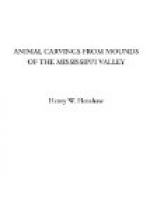Even if such explanation be not forthcoming, the “Elephant Mound” of Wisconsin should be supplemented by a very considerable amount of corroborative testimony before being accepted as proof positive of the acquaintance of the Mound-Builders with the mastodon.
As regards likeness to the mastodon, the pipes before alluded to, copies of which as given in Barber’s articles on Mound Pipes in American Naturalist for April, 1882, Figs. 17 and 18, are here presented, while not entirely above criticism, are much nearer what they have been supposed to be than the mound just mentioned.
[Illustration: Fig. 28.—Elephant Pipe, Iowa]
[Illustration: Fig. 29.—Elephant Pipe, Iowa.]
Of the two, figure 29 is certainly the most natural in appearance, but, if the pipes are intentional imitations of any animal, neither can be regarded as having been intended for any other than the mastodon. Yet, as pointed out by Barber and others, it is certainly surprising that if intended for mastodons no attempt was made to indicate the tusks, which with the trunk constitute the most marked external peculiarities of all the elephant kind. The tusks, too, as affording that most important product in primitive industries, ivory, would naturally be the one peculiarity of all others which the ancient artist would have relied upon to fix the identity of the animal. It is also remarkable that in neither of these pipes is the tail indicated, although a glance at the other sculptures will show that in the full-length figures this member is invariably shown. In respect to these omissions, the pipes from Iowa are strikingly suggestive of the Elephant Mound of Wisconsin, with the peculiarities of which the sculptor, whether ancient or modern, might almost be supposed to have been acquainted. It certainly must be looked upon as a curious coincidence that carvings found at a point so remote from the Elephant Mound, and presumably the work of other hands, should so closely copy the imperfections of that mound.
In considering the evidence afforded by these pipes of a knowledge of the mastodon on the part of the Mound-Builders, it should be borne in mind that their authenticity as specimens of the Mound-Builders’ art has been called seriously in question. Possibly the fact that the same person was instrumental in bringing to light both the pipes has had largely to do with the suspicion, especially when it was remembered that although explorers have been remarkably active in the same region, it has fallen to the good fortune of no one else to find anything conveying the most distant suggestion of the mastodon. As the manner of discovery of such relics always forms an important part of their history, the following account of the pipes as communicated to Mr. Barber by Mr. W. H. Pratt, president of the Davenport Academy (American Naturalist for April, 1882, pp. 275, 276), is here subjoined:




